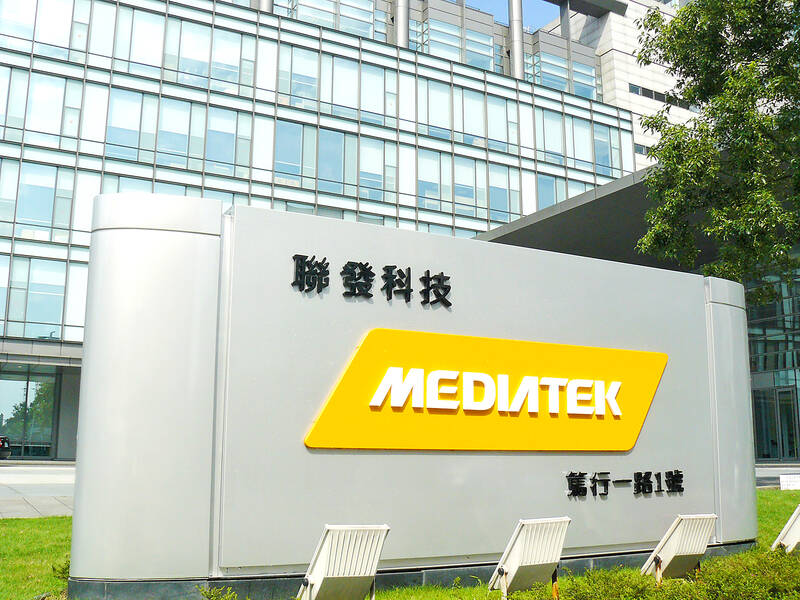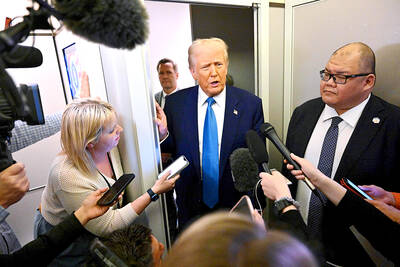MediaTek Inc (聯發科), the world’s biggest 5G smartphone chip designer, yesterday said that it expects revenue this quarter to return to growth at an annual rate of 17 percent at best, with the momentum to extend into the whole of next year given improving channel inventory, particularly on the smartphone front.
MediaTek’s inventory has returned to a healthy level of about 90 days following five consecutive quarters of effort, the chip designer told an online investors’ conference.
MediaTek customers also started replenishing mobile phone chips, which has helped drive earnings and would push its revenue to its highest in about five quarters, the company said.

.Photo: CNA
Revenue is expected to expand 11 to 17 percent year-on-year to between NT$120 billion and NT$126.6 billion (US$3.7 billion and US$3.9 billion) this quarter, MediaTek said.
That would be sequential growth of 9 to 15 percent from revenue of NT$110.1 billion last quarter, it said.
Gross margin would be 45.5 to 48.5 percent this quarter compared with 47.4 percent last quarter, the firm said.
“In the fourth quarter, we expect the strength in our mobile phone [business] to more than offset the seasonal decline of smart edge platforms,” MediaTek chief executive officer Rick Tsai (蔡力行) said.
Mobile phone chip revenue is to extend the growth trend and at a faster pace than last quarter’s 19 percent sequential increase, which was mainly fueled by the introduction of its new Dimensity 9300 flagship processor, Tsai said.
The new processor is expected to reach the market early next month.
The Dimensity 9300 processor, the third-generation MediaTek flagship mobile phone chip, is built on 3-nanometer process technology, the most advanced available from Taiwan Semiconductor Manufacturing Co (台積電), Tsai said.
The new processor elevates CPU and GPU performance, and has a powerful artificial-intelligence (AI) processing unit, which is optimized to run large-language models for generative AI.
MediaTek plans to unveil more processors with AI functions next year.
Generative AI features are “a must-have capability in our offering,” Tsai said.
Increasing computing capabilities, the proliferation of edge AI and increased adoption of semiconductor content for automotive applications would provide strong growth opportunities for MediaTek, he said.
Investors asked about any potential threat to MediaTek after Huawei Technology Co’s (華為) latest premium phone, the p60 Pro powered by a 7-nanometer processor, became a focal point of the market in the past few months.
Huawei was forced to exit the 5G market in 2019 due to the US’ technology curbs.
“We have no question in our mind that we are enabling our customers to compete effectively against whoever comes into the market, because we have great products,” Tsai said in response to an investor’s question. “At the end of the day, emotion can work for some time. I would expect rational consumer behaviors will prevail very shortly.”
Some customers would seek better and more advanced process technologies to satisfy demand for stronger computing power for gamers and generative AI features on mobile phones, MediaTek said.
Net profit climbed 15.9 percent to NT$18.57 billion during the quarter ended Sept. 30 compared with NT$16.02 billion in the second quarter, the firm said.
Last quarter’s earnings were the best since the fourth quarter last year, it said.
On an annual basis, net profit plunged 40.3 percent from NT$31.09 billion.
The company’s board of directors yesterday approved its first semi-annual cash dividend of NT$24.6 per common share made up of NT$16.6 of a regular cash dividend and NT$8 of a special cash dividend.

When an apartment comes up for rent in Germany’s big cities, hundreds of prospective tenants often queue down the street to view it, but the acute shortage of affordable housing is getting scant attention ahead of today’s snap general election. “Housing is one of the main problems for people, but nobody talks about it, nobody takes it seriously,” said Andreas Ibel, president of Build Europe, an association representing housing developers. Migration and the sluggish economy top the list of voters’ concerns, but analysts say housing policy fails to break through as returns on investment take time to register, making the

‘SILVER LINING’: Although the news caused TSMC to fall on the local market, an analyst said that as tariffs are not set to go into effect until April, there is still time for negotiations US President Donald Trump on Tuesday said that he would likely impose tariffs on semiconductor, automobile and pharmaceutical imports of about 25 percent, with an announcement coming as soon as April 2 in a move that would represent a dramatic widening of the US leader’s trade war. “I probably will tell you that on April 2, but it’ll be in the neighborhood of 25 percent,” Trump told reporters at his Mar-a-Lago club when asked about his plan for auto tariffs. Asked about similar levies on pharmaceutical drugs and semiconductors, the president said that “it’ll be 25 percent and higher, and it’ll

NOT TO WORRY: Some people are concerned funds might continue moving out of the country, but the central bank said financial account outflows are not unusual in Taiwan Taiwan’s outbound investments hit a new high last year due to investments made by contract chipmaker Taiwan Semiconductor Manufacturing Co (TSMC, 台積電) and other major manufacturers to boost global expansion, the central bank said on Thursday. The net increase in outbound investments last year reached a record US$21.05 billion, while the net increase in outbound investments by Taiwanese residents reached a record US$31.98 billion, central bank data showed. Chen Fei-wen (陳斐紋), deputy director of the central bank’s Department of Economic Research, said the increase was largely due to TSMC’s efforts to expand production in the US and Japan. Investments by Vanguard International

WARNING SHOT: The US president has threatened to impose 25 percent tariffs on all imported vehicles, and similar or higher duties on pharmaceuticals and semiconductors US President Donald Trump on Wednesday suggested that a trade deal with China was “possible” — a key target in the US leader’s tariffs policy. The US in 2020 had already agreed to “a great trade deal with China” and a new deal was “possible,” Trump said. Trump said he expected Chinese President Xi Jinping (習近平) to visit the US, without giving a timeline for his trip. Trump also said that he was talking to China about TikTok, as the US seeks to broker a sale of the popular app owned by Chinese firm ByteDance Ltd (字節跳動). Trump last week said that he had